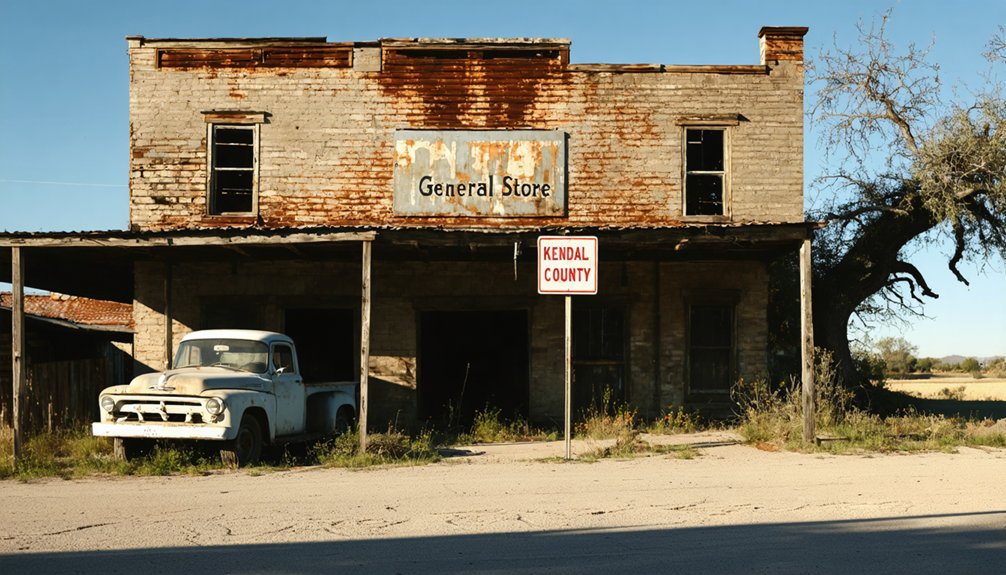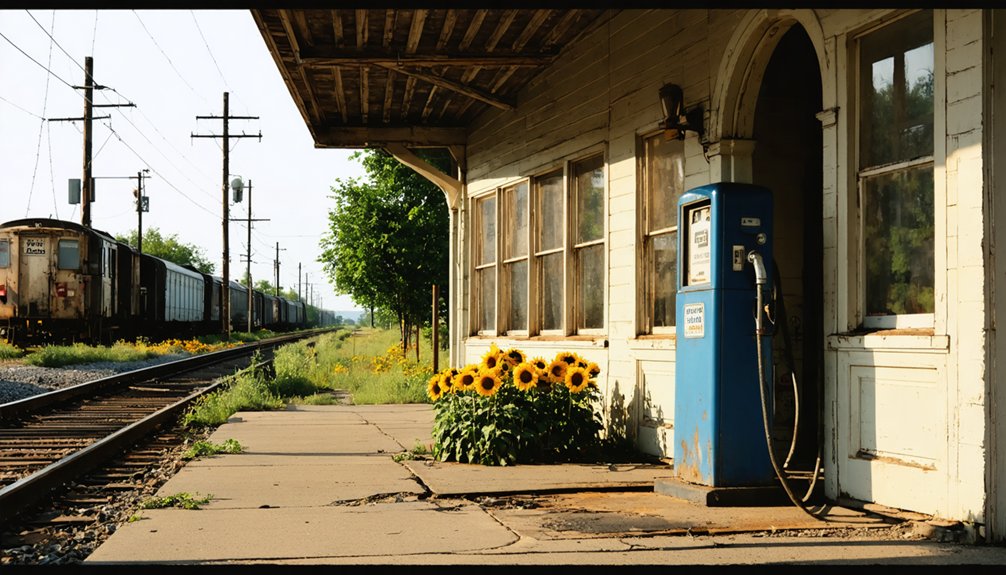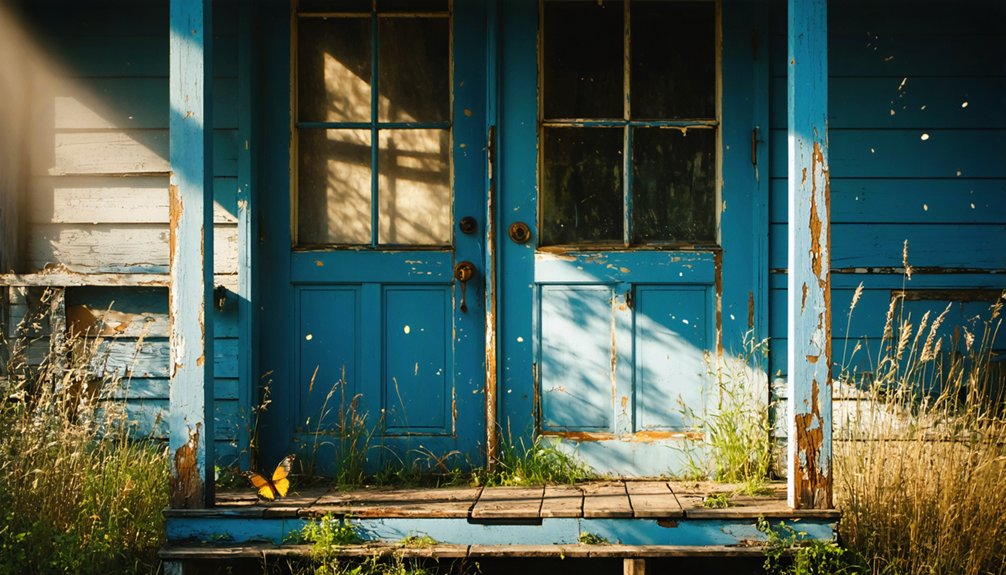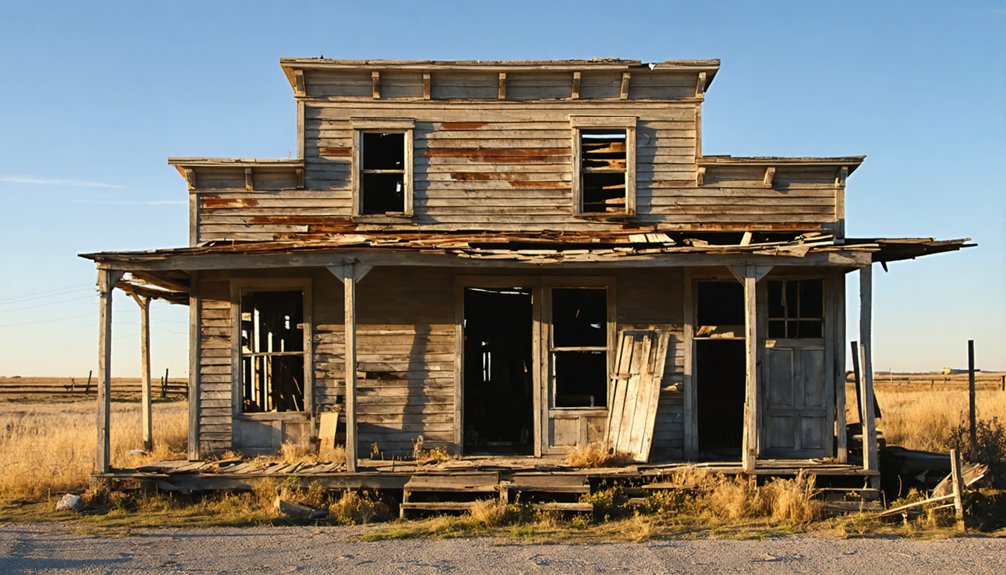You’ll find Welfare, Texas, off Interstate 10’s Exit 533, where German settlers established a community in the 1800s. The town got its name from store operator Alma Wohlfahrt, though it was originally called Bon Ton. While now considered a ghost town, Welfare maintains several historic structures, including its 1878 schoolhouse and original post office. The quiet rural setting along Joshua Creek holds fascinating tales of German immigrant life, community resilience, and local traditions.
Key Takeaways
- Originally named “Wohlfahrt” after a German store owner, Welfare developed as a German settlement before becoming a ghost town in modern Texas.
- The town reached its peak population of 275 residents in 1892, centered around cotton farming, ranching, and strong German cultural traditions.
- Welfare’s one-room schoolhouse, built in 1878 and relocated in 1902, stands as a Texas Historic Landmark and key ghost town attraction.
- Located off Interstate 10’s Exit 533, Welfare retains several preserved 19th-century structures, including the post office and historic homes.
- Despite its ghost town status, Welfare maintains its cultural heritage through annual gatherings and the preserved architectural elements of early Texas settlement.
The Story Behind Welfare’s Unique Name

The story of Welfare’s distinctive name traces back to its German roots as “Wohlfahrt,” meaning “pleasant trip” or “welfare” in German. The original name honored Alma Wohlfahrt, who ran the local store with her husband Perry Laas for many years.
You’ll find the name’s transformation was driven by practical needs. Train engineers struggled to pronounce “Wohlfahrt” at the station, leading to confusion and occasional humor.
By 1880, when the post office was established, the town had officially adopted the anglicized name “Welfare” – a simpler version that maintained the original German meaning while being more accessible to English speakers. This kind of disambiguation process helped prevent confusion among different locations with similar names.
This name change reflects a broader pattern in Texas Hill Country, where German immigrant communities often adapted their heritage to fit into the evolving American landscape. The change was particularly memorable as locals found humor at the train stop when passengers would request tickets to “Welfare.”
Life in Early Welfare: From Bon Ton to Present Day
You’ll find Welfare’s early pioneer life centered around its agricultural roots, with German settlers like Nicolaus Zink establishing themselves in the Texas Hill Country during the mid-to-late 19th century.
Your journey through Welfare’s history reveals a vibrant farming community that grew to 275 residents by 1892, supported by cotton cultivation and community involvement in local institutions like the schoolhouse.
When you explore Welfare’s daily routines from this era, you’ll discover how the town’s agricultural focus shaped everything from education to social structures, though severe weather and economic challenges would eventually alter this way of life. The settlement’s ranching activities followed similar patterns to those of early Spanish colonizers, who had introduced cattle and sheep to the Texas frontier. Like the mining town of Thurber, the community faced significant economic shifts that led to a dramatic population decline in later years.
From French Beginnings
While French exploration of Texas began with La Salle’s ambitious 1685 expedition, Welfare’s French connection stems from its original name “Bon Ton.” Located in Kendall County, this small settlement emerged long after the French colonial period had ended, though its initial French name reflected the cultural influences that persisted in Texas well after Spain had gained control of the territory.
La Salle’s original colony faced hostile raids from Karankawa tribes that ultimately contributed to its downfall. You can trace the evolution of French Settlement in Texas back to Fort Saint Louis near Lavaca Bay, where cultural exchange between Europeans and Native Americans shaped early colonial life. The fort’s establishment marked a pivotal moment in Texas’s colonial history, though its settlers faced numerous hardships.
Daily Pioneer Routines
Life in early Welfare centered around three primary activities: farming, education, and community gatherings.
You’d find most residents working their land, tending to crops and livestock in the German farming tradition. Pioneer agriculture wasn’t easy – severe weather and boll weevils frequently threatened harvests.
Your children would’ve attended the one-room schoolhouse built in 1878, where community spirit showed through parent-funded improvements like the 1912 porch addition. The schoolhouse stood proudly as a Texas Historic Landmark in 2000.
You’d join your neighbors for social events steeped in German heritage, maintaining cultural traditions through language and customs.
The railroad brought goods and visitors until 1930, when U.S. Highway 87’s bypass began isolating the town.
Daily routines gradually shifted as businesses closed and population declined, until the school’s closure in 1952 marked the end of Welfare’s pioneer era.
Historic Landmarks and Preserved Architecture
Despite its diminished population today, Welfare retains several historically significant landmarks that chronicle its pioneer heritage, with the Welfare School standing as the town’s primary preserved structure.
The school’s educational legacy began in 1878 as a one-room frame building on Joshua Creek before relocating to Waring-Welfare Road in 1902. Its architectural significance reflects typical rural Texas schoolhouse design, with community-driven expansions including a porch addition in 1912.
The humble schoolhouse grew with its community, transforming from a single room on Joshua Creek into a cherished piece of rural Texas heritage.
Like many semi-abandoned Texas towns, Welfare maintains a small but persistent population while preserving its historical sites. Similar to the failed frontier settlements across Texas, the town experienced a gradual decline from its once-thriving community status.
You’ll find the burial site of Nicolaus Zink, German pioneer and Sisterdale’s founder, as another notable landmark.
While most original structures have fallen into disuse since the town’s decline, the school’s preservation as Recorded Texas Historic Landmark #12370 in 2000 guarantees that Welfare’s pioneering spirit endures through its remaining architecture.
The Texas Hill Country Setting
Nestled within the rugged expanse of Texas Hill Country, Welfare occupies a distinctive ecological zone where the Edwards Plateau meets the Balcones Escarpment.
You’ll find yourself surrounded by limestone hills rising 400-500 feet above the surrounding terrain, creating a dramatic backdrop of natural features shaped by the region’s karst topography.
The area’s thin, rocky soil supports a diverse mix of vegetation, including live oaks, Ashe junipers, and native grasses. Scattered among these plants, you’ll find hardy species like yucca and prickly pear adding to the rugged beauty.
You’re in a shift zone between humid and semi-arid climates, where the Edwards Aquifer flows beneath your feet through an intricate network of caves and underground rivers.
This unique Hill Country setting creates a challenging environment where flash floods can occur during heavy rains, and the rugged terrain tells a story of geological forces that shaped this distinctive Texas landscape.
Why Welfare Isn’t Your Typical Ghost Town

The term “ghost town” might conjure images of abandoned buildings and empty streets, but Welfare defies these typical expectations. Unlike most abandoned settlements, you’ll find an active population still calling this place home, with community gatherings and events keeping the town’s spirit alive.
What sets Welfare apart is its gradual change rather than sudden abandonment. While the population has decreased from its 1890s peak of 275, preservation efforts have maintained several historic 19th-century structures, including the post office and original homes.
You’ll discover functional infrastructure and utilities, alongside working ranches and farms in the surrounding area. Instead of finding just ruins, you can experience a living historic site that continues to attract visitors while serving as a unique example of rural evolution in the Texas Hill Country.
Local Legends and Community Tales
While many ghost towns fade into silent obscurity, Welfare’s rich tapestry of local legends keeps its history vibrantly alive through stories passed down by generations of German immigrants and their descendants.
Local folklore tells of early settlers who battled harsh winters along the Guadalupe River, finding strength in communal solidarity. You’ll hear tales of secretive gatherings in church basements during turbulent times and stories centered around the historic St. John Lutheran Church, where community milestones were celebrated.
The town’s resilience shines through in accounts of the beloved Welfare Sausage Festival, where traditional German foods and music still unite families today.
Despite its ghost town status, community resilience persists as descendants maintain their ancestral connections through storytelling and annual gatherings.
Visiting Modern-Day Welfare

Located off Interstate 10’s Exit 533, modern-day Welfare beckons history enthusiasts down the Waring-Welfare country road to explore its semi-abandoned remains.
You’ll find yourself in a quiet rural setting along Joshua Creek, where the town’s historical essence remains largely untouched by modern amenities.
As you explore the site, you’ll discover the preserved one-room schoolhouse from 1878, a reflection of the community’s educational heritage before its closure in 1952.
Visitor tips: plan for a self-guided tour, as formal tours and interpretive signage are limited.
The peaceful surroundings offer an authentic glimpse into early Texas settlement life, though you’ll need to rely on your own research and imagination to piece together the town’s story, as tourist infrastructure is minimal.
Frequently Asked Questions
What Is the Current Population of Welfare, Texas?
You’ll find zero current residents in Welfare, reflecting population trends of rural abandonment. The town’s history shows a steady decline until it achieved ghost town status in modern times.
Are There Any Annual Festivals or Events Held in Welfare?
Like a lone wildflower in spring, you’ll find only one major Welfare tradition: the Annual Bluebonnet Festival, now in its 42nd year. Other community gatherings aren’t regularly scheduled in this quiet town.
Can Visitors Stay Overnight in or Near Welfare?
You’ll find several lodging options near Welfare, from Ghost Town Casitas to luxury hotels in nearby Terlingua. You can choose camping options, private casitas with outdoor showers, or historic accommodations with modern amenities.
What Happened to Welfare’s Original Post Office Building?
In a town that once served 275 residents, you’ll find the original post office was destroyed by fire, then rebuilt within a year, becoming an important architectural landmark in Welfare’s postal history.
Is There Public Access to the Historic Welfare Schoolhouse?
You’ll need to check with local historic preservation authorities for access, as there’s no documented public admission policy. Like many local legends, the schoolhouse’s accessibility remains unclear without official guidance.
References
- https://texashighways.com/travel-news/four-texas-ghost-towns/
- https://mix941kmxj.com/see-how-two-texas-ghost-towns-battled-for-the-county-and-lost/
- https://www.youtube.com/watch?v=fP2EVY0_O2k
- https://en.wikipedia.org/wiki/List_of_ghost_towns_in_Texas
- https://www.texasescapes.com/TexasHillCountryTowns/Welfare-Texas.htm
- https://texashillcountry.com/ghost-town-welfare-texas/
- https://www.texasescapes.com/TOWNS/Texas-Ghost-Towns-3-Hill-Country.htm
- https://www.tshaonline.org/handbook/entries/welfare-tx
- https://www.ksat.com/news/local/2023/03/21/ksat-explains-from-the-archives-we-take-a-look-back-at-the-best-of-how-did-that-town-get-its-name/
- https://en.wikipedia.org/wiki/Welfare



